224227
Titanium(IV) oxide, rutile
powder, <5 μm, ≥99.9% trace metals basis
Synonym(s):
Titanium dioxide
About This Item
Recommended Products
Assay
≥99.9% trace metals basis
form
powder
reaction suitability
reagent type: catalyst
core: titanium
particle size
<5 μm
density
4.17 g/mL at 25 °C (lit.)
SMILES string
O=[Ti]=O
InChI
1S/2O.Ti
InChI key
GWEVSGVZZGPLCZ-UHFFFAOYSA-N
Looking for similar products? Visit Product Comparison Guide
Related Categories
General description
Application
Rutile titanium(IV) oxide exhibit a high dielectric constant and can be used as a component in low-temperature cofired ceramics (LTCC) or as a filler in organic-inorganic composites.
Au/rutileTiO2 can be used as a photocatalyst for selective aerobic oxidation of amines to corresponding imines.
Features and Benefits
Other Notes
Storage Class Code
13 - Non Combustible Solids
WGK
nwg
Flash Point(F)
Not applicable
Flash Point(C)
Not applicable
Personal Protective Equipment
Choose from one of the most recent versions:
Certificates of Analysis (COA)
Don't see the Right Version?
If you require a particular version, you can look up a specific certificate by the Lot or Batch number.
Already Own This Product?
Find documentation for the products that you have recently purchased in the Document Library.
Which document(s) contains shelf-life or expiration date information for a given product?
If available for a given product, the recommended re-test date or the expiration date can be found on the Certificate of Analysis.
How do I get lot-specific information or a Certificate of Analysis?
The lot specific COA document can be found by entering the lot number above under the "Documents" section.
How do I find price and availability?
There are several ways to find pricing and availability for our products. Once you log onto our website, you will find the price and availability displayed on the product detail page. You can contact any of our Customer Sales and Service offices to receive a quote. USA customers: 1-800-325-3010 or view local office numbers.
What is the solubility of Product 224227, Titanium(IV) oxide, rutile?
We do not test the solubility of this product. However, according to the chemicals encyclopedia published by the Royal Society of Chemistry, 13th Edition, this product is insoluble in water, HCl, HNO3 and dilute H2SO4. It is expected to be soluble in hot concentrated H2SO4 and hydrofluoric acid.
What is the surface area of Product Product 224227, Titanium(IV) oxide, rutile?
According to our supplier, the surface area of this product is about 2-3 m2/g.
What does "Trace Metal Basis" mean?
For this product, the purity is determined by testing total metallic impurities. Our specifications only allow for a maximum of 1000 ppm. On the Certificate of Analysis, you will be able to see which metals were tested and the amount.
How much anatase is present in Product 224227, Titanium(IV) oxide, rutile?
We do not determine the amount of anatase form present. However, according to our supplier, this product may have a maximum of 10% anatase present.
What is the Department of Transportation shipping information for this product?
Transportation information can be found in Section 14 of the product's (M)SDS.To access the shipping information for this material, use the link on the product detail page for the product.
My question is not addressed here, how can I contact Technical Service for assistance?
Ask a Scientist here.
Our team of scientists has experience in all areas of research including Life Science, Material Science, Chemical Synthesis, Chromatography, Analytical and many others.
Contact Technical Service
